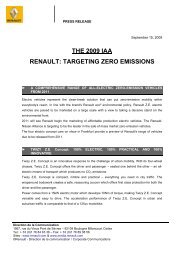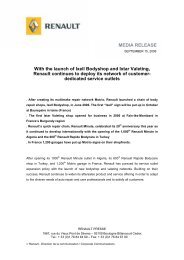ESP (Electronic Stability Program) - Renault
ESP (Electronic Stability Program) - Renault
ESP (Electronic Stability Program) - Renault
Create successful ePaper yourself
Turn your PDF publications into a flip-book with our unique Google optimized e-Paper software.
RENAULT COMMUNICATION<br />
Safety > <strong>ESP</strong> > Correction Sheet 10<br />
<strong>ESP</strong> (<strong>Electronic</strong><br />
<strong>Stability</strong> <strong>Program</strong>)<br />
><br />
Dynamic trajectory control, also known as <strong>ESP</strong> (<strong>Electronic</strong> <strong>Stability</strong> <strong>Program</strong>),<br />
assists the driver to retain control of his vehicle in the event of a loss of grip.<br />
Traction control operates alongside <strong>ESP</strong>.<br />
4<br />
Hydraulic link<br />
Electric link<br />
>BASIC FACTS<br />
The aim of <strong>ESP</strong> is to maintain the trajectory of the vehicle as<br />
the driver wishes it to be in turning the steering wheel. An<br />
abrupt emergency manœuvre, a bend taken too fast and even<br />
a damaged road surface can result in a loss of tyre grip, meaning<br />
that the driver is barely, if at all, in control of his trajectory.<br />
By detecting the warning signs of such phenomena, <strong>ESP</strong> helps<br />
the driver by attempting to correct the trajectory.<br />
2<br />
3<br />
1<br />
Components of the <strong>ESP</strong> system include:<br />
1 ı a sensor which combines two piece of information:<br />
lateral acceleration and rate of yaw<br />
2 ı a steering wheel angle sensor<br />
3 ı a disconnection switch<br />
4 ı specific management of engine torque<br />
IN SHORT >>><br />
Using data supplied by seven sensors, the <strong>ESP</strong><br />
computer acts selectively on the wheels so that the<br />
car returns to the intended trajectory. It does this<br />
by working in close conjunction with the ABS system.<br />
INIT-D1109EC0192<br />
>Mobility >Life on board >Environment >Safety
Safety > <strong>ESP</strong> > Correction Sheet 10<br />
>HOW DOES IT WORK?<br />
1<br />
THE COMPUTER<br />
To avoid sudden loss of adherence, <strong>ESP</strong> works selectively on<br />
each wheel and, if necessary, on engine torque. Take the case<br />
of a right-hand bend. If the car is tending to go straight on or is<br />
in understeer, <strong>ESP</strong> will force it to take the bend by applying<br />
braking pressure to the right rear wheel, and possibly the right<br />
front wheel. This creates a fulcrum which forces the car to<br />
take the bend (figure 1). In the same right-hand bend, if the<br />
car is tending to go into a spin or is in oversteer, <strong>ESP</strong> then<br />
acts on the front left wheel. By applying brake pressure to it, it<br />
creates purchase which forces the car to rectify its trajectory<br />
(figure 2).<br />
To perform these operations, <strong>ESP</strong> analyses the data provided<br />
by seven sensors and compares them with a reference model<br />
of the vehicle’s behaviour stored in its memory. The first<br />
sensor transmits the angle of the steering wheel. To verify<br />
whether the real trajectory of the car is complying with that<br />
desired by the driver, it processes the information fed to it by<br />
the other six sensors.<br />
First of all, the computer determines the speed of the vehicle<br />
by analysing the data provided by each wheel’s tachometers<br />
(those of the ABS). The computer also checks that the difference<br />
in speed of rotation between the right and left wheels<br />
conforms to the bend that the vehicle is negotiating. The<br />
analysis is further refined by data supplied by a sixth<br />
sensor, a gyrometer, which detects the vehicle's rotational<br />
movements around its vertical axis, also known as the rate of<br />
yaw. Finally, an accelerometer enables it to detect the onset of<br />
lateral slipping. Any discrepancy detected by the computer<br />
results from a deviation between the car’s real trajectory and<br />
that desired by the driver.<br />
The computer then acts selectively, applying brakes to one<br />
or more wheels. Here again, the system employs ABS circuits,<br />
and the selective braking of wheels is made possible by a<br />
constant dialogue between <strong>ESP</strong> and ABS functions. If the<br />
selective braking of wheels is insufficient to force the vehicle<br />
to adopt the correct trajectory, the computer then acts on<br />
engine torque by way of the throttle, injection or ignition.<br />
2<br />
UNDERSTEER CONTROL STRENGTHENS<br />
THE ACTION OF <strong>ESP</strong><br />
On <strong>Renault</strong> vehicles, the use of CSV Understeer Control further<br />
improves the action of <strong>ESP</strong>. Understeer Control can act on<br />
all four wheels at the same time. In view of the fact that, in certain<br />
extreme situations, this can lead to a sharp deceleration of<br />
the car, the hazard warning lights are automatically activated<br />
to alert other drivers.<br />
Understeer<br />
Oversteer<br />
RENAULT COMMUNICATION





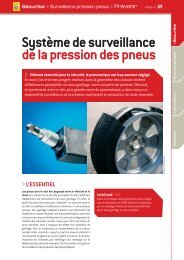
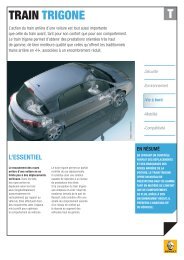
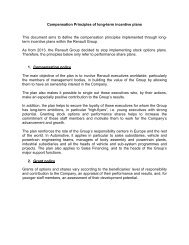
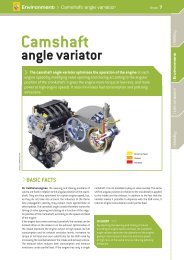
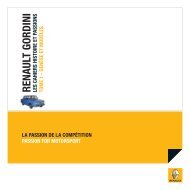
![[Environment] 01 ABS - Renault](https://img.yumpu.com/11783304/1/184x260/environment-01-abs-renault.jpg?quality=85)
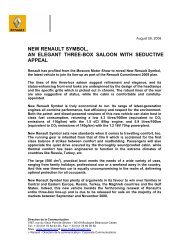
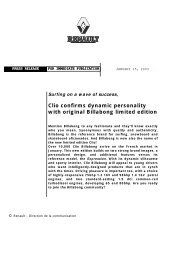

![[Groupe] CSR NEWSLETTER - Renault](https://img.yumpu.com/7406252/1/190x143/groupe-csr-newsletter-renault.jpg?quality=85)
